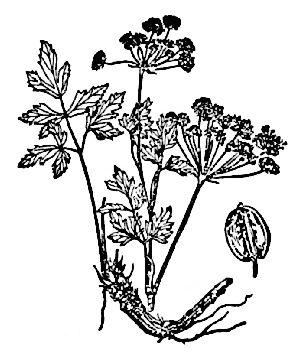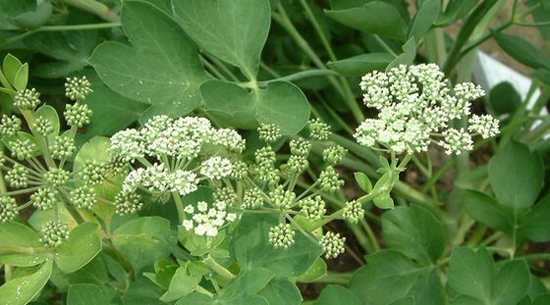- Lung Heat with coughing of thick sputum,
stifling sensation in the chest, and irritability, with
Morus
alba- Sang bai pi, and
Fritillaria
thunbergii or
Fritillaria cirrhosa-
Bei mu.
- Cough due to a disturbance in the normal function of the Lungs from an exernally
contracted disease, wtih Bai qian.
- Headache, fever, nasal congestion, runny nose, and cough associated with externally
contracted Wind Heat.
Qian hu and
Bupleurum
chinense- Chai hu both dispel Wind and relieve the stifling sensation and
distention in the chest and epigastric areas. However, the Qian hu transforms
phlegm and reestablishes the normal downward flow of Lung Qi, it is therefore
used for the more obvious symptoms of cough associated with externally contracted
disease. Chai hu releases the extrior, reestablishes the normal dissemination
of Liver qi, and is used for malarial disorders due to exernally contacted disease.
They can be used together for externally- contracted diseases presenting with
cough, rebellious Qi, thick sputum, and/or malarial disorders.
[1] Barefoot Doctor's Manual- 1977 Prepared
by the Revolutionary Health Committee of Hunan Province. Original Chinese manual-
Victor W. Sidel. Originally published by Dr Joseph Quin and the Fogarty International
centre, Bethdesda (1974). Madrona Publishers Seattle Washington ISBN 0-914842-52-8
[2] A Complete English Dictionary of Medicinal Terms in Chinese Acupuncture
and Herbalism 1981- Henry Lu Chinese Foundations of Natural Health- The Academy
of Oriental Heritage, Vancouver, Canada.
[3] Chinese Herbal Medicine Materia Medica- Dan Bensky and Andrew Gamble- Eastland
Press 1986 Seattle Washington ISBN 0-939616-15-7
Images
1,2.
epharmacognosy.com
P. praeruptorum; Praeruptorins A-D
P. decursivi; decusin, nodakenin, spongesterol, volatile oil, mannitol.[1]
References
[1] Chinese Herbal Medicine Materia Medica- Dan Bensky and Andrew Gamble- Eastland
Press 1986 Seattle Washington ISBN 0-939616-15-7
 HABITAT:
HABITAT: Peucedanum
praeruptorum. P. decursivum
前
胡
Qián hú Hogfennel
root Family: Umbelliferae
Peucedanum
praeruptorum. P. decursivum
前
胡
Qián hú Hogfennel
root Family: Umbelliferae

 HABITAT:
Grows wild in the sun among damp thickets on hillsides and waste places.
HABITAT:
Grows wild in the sun among damp thickets on hillsides and waste places.